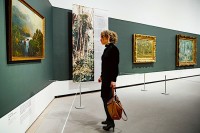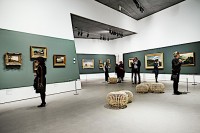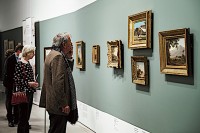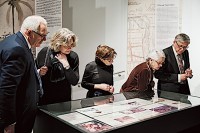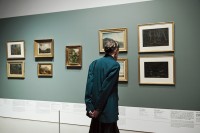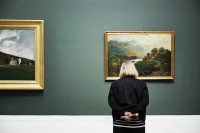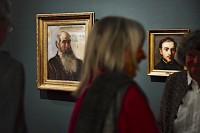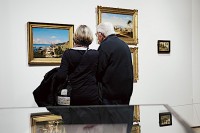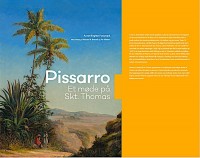The browser will either open the file, download it, or display a dialog.
Camille Pissarro: Meeting on St. Thomas
Ordrupgaard Museum, Copenhagen
March 10–July 2, 2017
Catalogue:
Camille Pissarro: Et møde på Skt. Thomas.
Essays by Anne-Birgitte Fonsmark, Richard Brettell, and Per Nielsen.
Copenhagen: Ordrupgaard, 2017.
200 pp.; 169 color illus.; checklist.
ISBN: 978-87-88692-23-5
Copenhagen’s spring exhibition at the Ordrupgaard, Camille Pissarro: Et Møde på Skt. Thomas [Meeting on St. Thomas] delighted the viewer with color, a balanced layout, and clear text (fig. 1). The exhibition, curated by Ordrupgaard director Anne-Birgitte Fonsmark, maintained a strict chronology and focused narrowly on the early work of Pissarro in St. Thomas, Venezuela, and after his arrival in Paris in 1856. In approximately 1850, Pissarro (1830–1903) met the Danish painter Fritz Melbye (1826–69) in Pissarro’s home city of Charlotte Amalie, St. Thomas, Virgin Islands, at that time a Danish colony. The adventurous Melbye had left Denmark seeking exotic painting locations in the New World; the busy St. Thomas port was a transfer center for ships like Melbye’s that carried passengers and goods across the Atlantic.
Fonsmark integrated paintings from European, American, and Venezuelan collections with a significant number of drawings from the Pissarro family legacy housed at the Ashmolean Museum, Oxford, and a trove of works on paper by Melbye and Pissarro found in the 1990s at the Frederic Edwin Church estate, Olana State Historic Site, Hudson, New York. Richard Brettell’s renowned scholarship informed the exhibition and the American scholar also contributed a short essay to the catalogue. Meeting at St. Thomas successfully revived interest in Pissarro’s early period in the Caribbean and South America and raised questions that merit closer study. Additionally, the Ordrupgaard exhibition demonstrated a direct link between plein-air practice in the Danish Golden Age and a significant French Impressionist.
The exhibition designers wrapped the main gallery space in a wide band of lush, bluish green, complementing the viewing of tropical landscapes and especially resonating with the large number of Melbye’s finished paintings executed between 1852 and 1854, when he and Pissarro shared a studio in Caracas and traveled throughout Venezuela (fig. 2). Other than large vertical banners of wall text presenting the theme of the rooms, few didactics interrupted the horizontal stripe of strong color. Instead, the curatorial explanations, offered in both Danish and English, were placed below knee-height in a ribbon of white about 18” high along the floor of the room. This choice privileged the paintings over interpretation and the effect was striking (fig. 3). The low placement of labels, however, may have also limited the impact of the curator’s message; many casual viewers may have missed the important textual explanations.
The curators took advantage of local knowledge about the Danish Golden Age landscape tradition to demonstrate its relevance to Pissarro’s development as a painter, particularly through the influence of Fritz Melbye. Whereas American audiences might require much more explication of the Danish landscape tradition and the painting school centered around Christoffer Wilhelm Eckersberg (1783–1853), Fonsmark’s curatorial team situated the Melbye family in the well-known context of the 1840s and considered the implications of the partnership between Fritz, a Golden Age painter, and the more famous Pissarro. At the start of the Danish Golden Age, around 1816, artists chose to depict national architectural and historical monuments, as well as more romantic images of land and sea that conveyed a sense of the divine or the sublime.[1] By the 1830s, cultural leaders and middle-class patrons alike demanded subjects based on observation of specific localized topography, climate, and light.[2] View Outside the North Gate of the Citadel (1834) by Christen Købke (1810–48) demonstrates qualities of bright sunshine, familiar locations, and lack of narrative.[3]
A plethora of plein-air oil sketches by Melbye and Pissarro relate to the instructional methods preferred by Eckersberg, and practiced by the three affiliated Melbye brothers (Anton, Vilhelm and Fritz). Eckersberg taught his students to work from life and to record nature with utmost detailed accuracy.[4] Melbye’s brother Vilhelm was the first Danish painter to paint outdoors at Skagen, later known as one of Denmark’s centers for plein-air painting (18). Fritz Melbye adhered to Eckersberg’s instruction with careful observation for studies of aloe and close-up views within the dense tropical forest, although choosing to paint the Caribbean and South America rather than preferred Danish landscapes (117–23). Pissarro’s first known plein-air oil sketches follow his initial encounter with Melbye around 1850, and indicate a new development in his practice. His marks became increasingly confident, demonstrating a command of light, shadow, and composition while working alongside the Danish painter in Venezuela. Through the juxtaposition of Melbye and Pissarro, Fonsmark’s exhibition convinces the viewer that Pissarro developed a preparatory practice that is rooted in the Danish Golden Age. Both the catalog and the exhibition juxtapose pencil drawings and oil sketches from 1850 through 1852, such as their views of the Danish Virgin Islands, which Melbye and Pissarro sketched side by side (41). Pissarro’s on-site pencil sketches from Venezuela illustrate the local rock formations, trees, and plant life (81, 108–09). Like his friend, who had been trained in Eckersberg’s method, Pissarro worked from life, always equipped with his sketchbook whether in Caracas or in the tropical forests. He dashed off quick sketches depicting the lively bustle on the streets and in taverns of Caracas (92–97). One of Pissarro’s more complex preparatory drawings, Landscape with Figures by a Stream, aligns with both Købke’s preference for humble scenes and Eckersberg’s requirements for observation (66–67). Among the exotic and rugged terrain, Pissarro depicted a scene of daily life, bathing, washing, and watering of donkeys. Pissarro’s plein-air practice, central to his later Impressionist style, develops through a lineage related to Melbye and independent of the French Barbizon school.
Despite the exhibition title’s suggestion that the focus would be on the Caribbean, the layout and didactics brought more attention to Pissarro’s travels with Melbye to Venezuela between 1852 and 1854. This emphasis arises, in part, from the irregular circulation in Zaha Hadid’s 2005 architectural addition to the museum. Although appealing in design, the layout confused the curatorial sequencing of the show. The entrance foyer broke up the exhibition, with two smaller galleries tucked behind the visitor’s desk that were mostly dedicated to the Caribbean context (fig. 4). The shape and size of these rooms and displays led to frequent congestion, discouraging adequate attention to the content. The larger gallery, on the opposite side of the visitor’s reception area, had clearer signage and welcomed the viewer with ample space and a beautiful green palette.
This main gallery, in fact, fully engaged viewers in Melbye and Pissarro’s association in Venezuela, a nation that attracted free-thinkers from around the world (fig. 5). Furthermore, the lavishly illustrated writings of the naturalist Alexander von Humboldt (1769–1859) popularized the South American country as a picturesque region that would be sought out by the next generations of artists. Humboldt’s volumes, which were widely read by the Danish intelligentsia in Copenhagen and probably St. Thomas, recommended scientifically based art with accurate visual descriptions and records of nature and topography. Despite other claims connecting this period in Venezuela to Pissarro’s subsequent priorities in the 1870s and 1880s, the exhibition unfortunately missed an important logical segue from this scientific context, a vestige of the time spent with Melbye and a link to the Golden Age. Throughout his long career and despite affiliations with many avant-garde movements, Pissarro remained committed to aesthetics based on direct observation.[5] In his review of the 1868 Salon, “Les naturalistes,” Emile Zola emphasized that Pissarro’s painting explored observable nature and depicted quotidian existence: “His canvases, which lack all fireworks and spice, discover a nature too living and too pungent in its reality.”[6] Direct observation and the intersection of science and aesthetics as advocated by Humboldt might also be seen as intellectual preparation for Pissarro’s later experiments with the technical color theories of Charles Henry.[7] Fonsmark does not continue this line of inquiry from the Golden Age and Humboldt to Positivism and the scientific aesthetics of Neo-Impressionism. She instead offers only a rather limited claim about how this exhibition relates to Pissarro’s more famous mature work, how the density of foliage depicted by Pissarro in Venezuela is something that he would revisit in Pontoise (see fig. 1).
Despite their strong aesthetic appeal, the green walls of the exhibition privileged Melbye’s oils over Pissarro’s more subtle drawings, watercolors, and works on paper, which were appropriately installed in cases. Pissarro, a slightly younger and considerably less experienced artist, finished fewer canvases than Melbye during their period of collaboration. Furthermore, the most powerful tropics painting exhibited was Melbye’s The Blue Hole, Jamaica (1866; fig. 6). In fact, although the quantity of works by Melbye and by Pissarro were nearly equal, of the 170 exhibited, there were only about a dozen oil paintings by Pissarro dated before 1856. In addition, although providing a clear visual field to consider the paintings, the placement of the texts and attributions low on the wall made it easy for visitors to overlook the relevant relationship of a drawing to a painting, or between two scenes. The display put the text at an uncomfortable reading distance, and almost made it mandatory to review the catalogue to understand why Melbye’s presence was so strong in an exhibition dedicated to Pissarro.
What made this exhibition truly special was the thoughtful consideration of Melbye as a painter and what it meant to both painters to work side by side. The show’s title, focusing solely on Pissarro, was misleading. A more accurate title, although probably not as marketable, would have emphasized the collaboration that resulted from the meeting in St. Thomas, such as “Pissarro AND Melbye” (fig. 7). In his catalogue essay, Brettell refers to Joachim Pissarro’s argument in his 1993 thesis, that these two artists demonstrated a different model of education through association, not teacher and student, but cooperation between colleagues at differing stages in their careers (175). The show effectively elucidates an artistic partnership between Pissarro and Melbye, which facilitated both mutual and independent development. This insight fosters a more nuanced understanding of the more famous French Impressionist and adds complexity relevant to the Danish Golden Age. Despite the academic merit of a double billing of Pissarro and Melbye in St. Thomas, however, signaling a dual emphasis probably would not have drawn as wide an audience.
The show’s pairing of Melbye and Pissarro reveals intertwined motifs, locations, and styles during this period. Several sketches were identified as by “Fritz Melbye or Camille Pissarro,” such as the extensively worked graphite Tropical Forest Grotto, displayed in both the catalog and the exhibition next to a watercolor of the same view with similar light values that was signed by Melbye (46–47). The curators drew attention to visual similarities and shared vantage points and forced the viewer to repeatedly question authorship, especially since the labels were removed from eye level. In the installation and the catalogue, Fonsmark challenged a prevailing narrative that distinguishes between Melbye and Pissarro, based on the latter as selecting more intimate subjects and focusing more narrowly on a cropped scene. Rather, the exhibition demonstrated that in Venezuela, Pissarro also chose panoramic scenes, such as a pencil sketch overview of Caracas. However, the removal of labels from the visual field may again have actually reduced the effectiveness of these comparisons in the exhibition; in my unscientific sampling, most of the attendees read the large scale thematic explanations, but only rarely stopped to consider the text under these groupings, which had been removed from their field of vision.
Hooked by the exhibition title, Camille Pissarro: Meeting in St. Thomas, I was disappointed not to learn more about St. Thomas as an artistic and cultural milieu. The year 2017 marked the centennial of Denmark’s sale of the Virgin Islands to the United States. The text in the exhibition and the catalogue differentiated the aims of the Ordrupgaard exhibition from multiple other exhibitions in Denmark marking the anniversary. Therefore, only the smaller rooms offered information about life in the West Indies as a scenic backdrop and helped to distinguish the different geographies and histories of St. Thomas and St. Croix relative to sugar, slavery, and commerce (see fig. 4). The strongest point made relative to St. Thomas was that it was a site of encounter and departure, a cosmopolitan center where goods and people from multiple continents interacted. Sadly, this point was not fully developed, except as a context for how Melbye and Pissarro came to know each other. The show would have been richer by expanding on the unique culture of St. Thomas, in which Pissarro grew up. The Pissarro family business as purveyors of European and West Indian merchandise offered the young Pissarro numerous opportunities for other types of “meetings on St. Thomas” as thousands of merchant ships from all over the world visited these strategically placed islands annually (24). It was on the docks that Pissarro first painted. Furthermore, his education in a school founded to teach slave children provided yet another type of “meeting on St. Thomas.” As a clerk in an export business and as a product of local schools, Pissarro gained early exposure to St. Thomas’s rich culture, a Caribbean environment that Melbye and others believed was exotic.
One of the markings of a strong exhibition is the degree to which it provokes new questions and offers insight into the subject. The Ordrupgaard presentation on Pissarro delivered here. This installation reminded a new generation of scholars that the American painter Frederic Edwin Church, associated with the Hudson River School in the United States, interacted with a painter from the Danish Golden Age as well as a community of free-thinkers and artists who gathered in Venezuela. Both the Danish and American Romantics elevated the cultural significance of landscape painting, thus laying the foundation for the later development of Impressionism in Denmark and the United States; in this context, a juxtaposition of these movements might lead to significant new insights.
The exhibition likewise hints at the importance of two kinds of networks, one fostered through global markets and one cultivated by Jewish families and relations. Fonsmark points out in her catalogue essay that freedom of religion in the Danish crown colony made it a haven for Jews experiencing persecution in Europe (25). The Ordrupgaard exhibition and catalogue denies the characterization of Pissarro as estranged from his family, noting that members of his family also resided in Paris where they cultivated connections to both the Danish and French Jewish communities (145). Fonsmark also introduces a second Danish painter in Pissarro’s circle, the young Jewish artist David Jacobsen, and explains that Pissarro’s acquaintances from St. Thomas, both Danes and Jews, made up his first circle of associates and friends in Paris.
St. Thomas’s importance as a node in the global economy is also a promising thread. This exhibition refers to many types of markets without developing that theme. Similarly, Pissarro’s intention to be a “Caribbean painter” is mentioned several times, but not explored in terms of the marketability of such images at home or abroad. Pissarro during this earliest period already suggests that he strategically assessed the art market by analyzing who his potential buyers might be—French collectors, travelers to the Caribbean, or the bankers and bourgeoisie in South America—and whether they preferred paintings of Venezuela or St. Thomas (fig. 8).
Finally, the depiction of race and class might have been more directly and convincingly addressed, especially as it related to the artist’s development within the context of St. Thomas. Pissarro sketched on the docks, but in this exhibition, such unfinished and awkward early efforts pale in contrast to the strong colors and bolder landscapes from the tour with Melbye in Venezuela. Melbye and Pissarro depict race from different vantage points, as a tourist or as a member of the capitalist elite, yet the exhibition does not make any note of this. The richly illustrated Ordrupgaard catalogue helpfully reproduces excellent quality images, where the viewer can better see the mark-making and gradations of light and shadow than in the display cases, thus inviting a more complex discussion of European representation of colonial subjects.
In her essay, Fonsmark claims that examples such as the pencil sketch, Four Women, Two Children and Dog in Front of a Café (1852), anticipated Pissarro’s lifelong fascination with peasant life (33). Such images, however, occurred within a charged racial context, which begs for discussion by an alternate voice that might tackle the market for images of race and slavery, as well as the problem of Pissarro’s initial intent to establish himself in Paris as “a painter of Caribbean life.”[8] Certainly the 1856 paintings, made soon after Pissarro arrived in Paris, suggest that he had hopes of profiting from demand for paintings of island culture. There is likewise room for a more critical evaluation of evidence of what Brettell describes as Pissarro’s “distinct tolerance” in these early works (55). Mia Laufer in 2014 convincingly challenged Brettell’s position with regards to the Venezuela paintings, which he reaffirms in this catalogue: “Because Pissarro had originally been to school with Afro-Caribbean children of slaves and because his family was largely rejected by a part of the island’s large and powerful Jewish congregation, the artist had a distinct tolerance to people of other race and origin throughout their lives than himself, and this is clearly reflected in his early works.”[9] Laufer accepts that Pissarro’s paintings may reflect a relatively neutral position; however, she points out that in order to increase salability of his Venezuela paintings at Paris galleries in the 1860s, Pissarro capitalized on popular Orientalist tropes.[10]
The Ordrupgaard catalogue, scheduled for publication in English in June 2018, reiterates and expands on the findings of the exhibition (fig. 9). High quality, well-sized images, many unfamiliar to audiences and scholars, add significant value. Three essays supplement the curator’s forward. Fonsmark’s “Et Møde på Skt. Thomas” [A Meeting on St. Thomas] narrates the main themes of the exhibition and expands on the original wall texts and didactics. She situates Melbye within the Danish Golden Age and includes biographical sketches of both painters. The chronological integration of relevant paintings and sketches from the trip to Venezuela, and from the late 1850s in Paris, visually reinforces the content of the text and the layout of the original show. However, the importance of plein-air oil sketching in the Danish tradition was more compelling in the exhibition than in the catalogue. This significant finding is buried about one hundred pages into Fonsmark’s lengthy essay. In truth, the catalogue would be more useful and engaging with shorter, focused, and readable articles that developed the themes more closely, rather than the curator’s 160-page, comprehensive exposition (112; 146–49). Sometimes this long essay gets bogged down in details, for instance, the six-page section justifying attribution of works to Pissarro or to Melbye (39–45).
Two very short essays, one by Richard Brettell, “Camille Pissarro and Fritz Melbye: A Brilliant Start in the New World” and the other by historian Per Nielsen, “Where Ships, Goods and People Meet: St. Thomas around 1850” help balance Fonsmark’s piece with their more precise scope. Brettell explains that the works exhibited at the Ordrupgaard highlight the differences in location, socialization, and training of Pissarro in comparison with the other French Impressionists. Brettell also reiterates the importance of correct attribution, a challenge that builds off his work for the 1997 exhibition, Camille Pissarro in the Caribbean, 1850–1855: Drawings from the Collection at Olana, at New York’s Jewish Museum. Per Nielsen is a Danish historian who specializes on the West Indies. His excellent essay provides welcome context and a concise well-written chronology of Denmark’s Caribbean territories and describes the environs of Charlotte Amalie and the Danish Virgin Islands. Nielsen’s piece better acquaints the reader with context than the small room at the exhibition (see fig. 4). The essay begged to be accompanied by graphics, maps, and relevant visuals related to the changes in the West Indies during the nineteenth century. Sadly, the catalogue lacked these sorts of visuals and the relevant display was the weakest part of the exhibition. Nielsen’s essay should, however, provoke scholars to consider the local population, heterogeneity, Danish colonial policy, interchange, and trade in future studies of Pissarro.
The Ordrupgaard must be commended for a visually compelling exhibition that raises many complex issues, and yet satisfies the viewer’s curiosity about Pissarro’s development of an artist in the Caribbean and Venezuela. It was a show about more than Pissarro, about more than two associated painters, Melbye and Pissarro. The curator’s concept of St. Thomas as a meeting point, a place of encounter, extends beyond the roles played by individual artists and national groups. It encourages scholars and visitors to consider how a context of collaboration and association nourishes artistic production.
Alice M. Rudy Price, PhD
Adjunct Instructor
Temple University, Tyler School of Art
alice.price[at]temple.edu
[1] Patricia Berman, In Another Light: Danish Painting in the Nineteenth Century (New York: Vendome Press, 2007), 93–132. Berman’s chapter “Picturing Denmark in the Golden Age” is an excellent source for more information on this period in Danish art.
[2] Berman, 102–04.
[3] David Jackson, Christen Købke: Danish Master of Light (New Haven and London: Yale University Press in association with National Galleries of Scotland, 2010), 16.
[4] Jackson, 25.
[5] James H. Rubin, Impressionism, Art and Ideas Series (London and New York: Phaidon, 2008), 324.
[6] Émile Zola, “Les Naturalistes,” Salon of 1868, quoted and translated by Rachael Ziady Delue, “Pissarro, Landscape, Vision, and Tradition,” The Art Bulletin 80, no. 4 (1998): 721.
[7] Rubin, 318. The author discusses Charles Henry’s Scientific Aesthetic (1885) as one treatise that was inspirational for the Neo-Impressionists.
[8] Mia Laufer, “Pissarro’s Second Search for Independence in Venezuela,” Hemisphere: Visual Cultures of the Americas 7, 1 (2014): 59, accessed November 25, 2017, http://digitalrepository.unm.edu/hemisphere/vol7
/iss1/6.
[9] Richard Brettell, “Camille Pissarro og Fritz Melbye: En strålende start i den nye verden,” in Camille Pissarro: Et møde på Skt. Thomas, exh. cat. (Copenhagen: Ordrupgaard, 2017), 176. “Fordi Pissarro oprindelig havde gået i skole med afro-caribiske børn af slaver, og fordi hans familie i høj grad blev afvist af en del af øens store og magtfulde jødiske menighed, havde kunstneren hele livet en udpræget tolerance over for folk af anden race og oprindelse end ham selv, og dette træder tydeligt frem i hans tidlige værker.” Laufer, 55; translated by the author.
[10] Laufer, 55.


